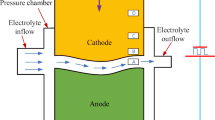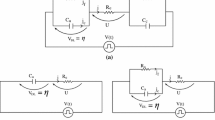Abstract
Simulation of the temperature distribution during the Pulse Electrochemical Machining (PECM) process provides information on system design and guidelines for practical use. The pulses that are applied to the PECM system have to be described on a time scale that can be orders of magnitude smaller than the time scale on which the thermal effects evolve. If the full detail of the applied pulses has to be taken into account, the time accurate calculation of the temperature distribution in PECM can become a computationally very expensive procedure. A different approach is used by time averaging the heat sources of the system. Performing this, the time steps used during the calculations are no longer dictated by the pulse characteristics. Using this approach, computationally very cheap, yet satisfying results can be obtained. In previous work of the authors, the hybrid calculation and the Quasi Steady State ShortCut (QSSSC) were introduced. This method allows to perform simplified calculations while getting satisfactory results. The method introduces errors however, which were quantified using analytical solutions and found to be acceptable. The results applied only to rectangular pulses. In this work, the more general case of arbitrary pulse forms is considered using a spectral approach.





Similar content being viewed by others
Abbreviations
- 1D:
-
One dimensional
- ECM:
-
Electrochemical machining
- PECM:
-
Pulse electrochemical machining
- QSS:
-
Quasi steady state
- QSSSC:
-
Quasi steady state shortcut
- SS:
-
Steady state
- A :
-
Pulse scale factor (K)
- Bi :
-
Biot number \((=\frac{hH}{k}) (-)\)
- C p :
-
Heat capacity (J kg−1 K−1)
- Fo :
-
Fourier number \((=\frac{\alpha^{\prime}t}{H^2}) (-)\)
- h :
-
Heat transfer coefficient (W m−2 K−1)
- H :
-
Characteristic size electrode (m)
- J :
-
Current density (A m−2)
- k :
-
Thermal conductivity (W m−1 K−1)
- n :
-
Spectral component index (–)
- P dl :
-
Heat density produced in the double layer (W m−2)
- P bulk :
-
Heat density produced in the bulk (W m−3)
- t :
-
Time (s)
- t′:
-
Time (s)
- T :
-
Pulse period (s)
- T′:
-
Dimensionless pulse period (–)
- v :
-
Scalar velocity (m s−1)
- \(\overline{v}\) :
-
Velocity vector (m s−1)
- x :
-
Distance (m)
- x′:
-
Dimensionless distance (–)
- α:
-
Duty cycle (–)
- α′:
-
Thermal diffusivity (m2 s−1)
- η:
-
Overpotential (V)
- θ:
-
Relative temperature (K)
- \(\overline{\theta}\) :
-
Averaged temperature (K)
- \(\tilde{\theta}\) :
-
Temperature ripple (K)
- θ decay :
-
Decaying temperature (K)
- Θ:
-
Temperature (K)
- Θ∞ :
-
Reference temperature (K)
- Θ*:
-
Electrolyte temperature (K)
- \(\hat{\lambda}_{n}\) :
-
Transcendental coefficients (–)
- ρ:
-
Density (kg m−3)
- σ:
-
Electrical conductivity (S m−1)
- τ:
-
Time constant (s)
- ω:
-
Angular frequency (s−1)
- ψ:
-
Pulse delay (s)
References
Lohrengel M, Klueppel I, Rosenkranz C, Betterman H, Schultze J (2003) Microscopic investigations of electrochemical machining of Fe in NaNO3. Electrochim Acta 48(20–22):3203–3211
Mount A, Clifton D, Howarth P, Sherlock A (2003) An integrated strategy for materials characterisation and process simulation in electrochemical machining. J Mater Process Technol 138:449–454
Rajurkar KP, Zhu D, McGeough JA, Kozak J, De Silva A (1999) New developments in electro-chemical machining. Ann CIRP 48(2):567–579
Kozak J, Rajurkar K (1991) Computer simulation of pulse electrochemical machining (PECM). J Mater Process Technol 28(1–2):149–157
Kozak J (2004) Thermal models of pulse electrochemical machining. Bull Pol Acad Sci: Tech Sci 52(4):313–320
Datta M, Landolt D (1981) Electrochemical machining under pulsed current conditions. Electrochim Acta 26(7):899–907
Kozak J, Rajurkar K, Lubkowski K (1997) The study of thermal limitation of electrochemical machining process. Trans NAMRI/SME XXV, 159–164
Clark W, McGeough J (1977) Temperature distribution along the gap in electrochemical machining. J Appl Electrochem 7:277–286
Loutrel S, Cook N (1973) A theoretical model for high rate electrochemical machining. ASME J Eng Ind 95(B/4):1003–1008
Smets N, Van Damme S, De Wilde D, Weyns G, Deconinck J (2007) Calculation of temperature transients in pulse electrochemical machining. J Appl Electrochem 37(3):315–324
Smets N, Van Damme S, De Wilde D, Weyns G, Deconinck J (2007) Time averaged temperature calculations in pulse electrochemical machining, part I: theoretical basis. J Appl Electrochem 37(11):1345–1355
Smets N, Van Damme S, De Wilde D, Weyns G, Deconinck J (2008) Time averaged temperature calculations in pulse electrochemical machining, part II: numerical simulations. J Appl Electrochem 38(4):551–560
Carslaw HS, Jaeger JC (1959) Conduction of heat in solids. Oxford University Press, New York.
Strauss W (1992) Partial differential equations: an introduction. Wiley, New York
Author information
Authors and Affiliations
Corresponding author
Rights and permissions
About this article
Cite this article
Smets, N., Van Damme, S., De Wilde, D. et al. Time averaged temperature calculations in pulse electrochemical machining, spectral approach. J Appl Electrochem 39, 791–798 (2009). https://doi.org/10.1007/s10800-008-9723-z
Received:
Accepted:
Published:
Issue Date:
DOI: https://doi.org/10.1007/s10800-008-9723-z




